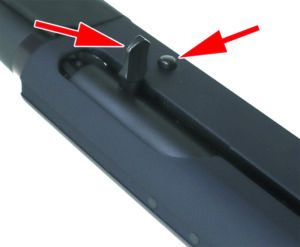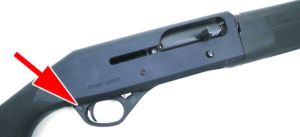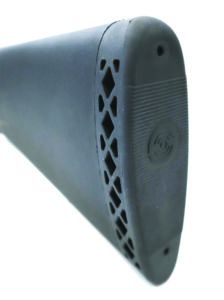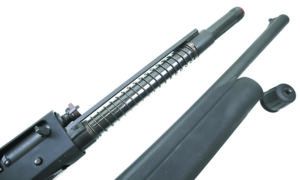Semi-automatic defensive shotguns offer softer recoil and faster follow-up shots compared to a pump-action shotgun. Semi-autos are also more expensive and require more maintenance than the ubiquitous pump gun, and they come in different operating actions — inertia operated and gas operated. In the gas-operated category itself, there are different types of gas-operated shotguns. So we decided to take a look at three semi-automatic shotguns with different operating actions.
The Stoeger M3000 Defender uses a simple inertia-operated action with a two-piece bolt and spring. Your shoulder basically helps cycle an inertia-operated gun. The plus side with an inertia-operated gun is there is less maintenance since there is no gas piston to foul. All the gas from the shot goes down the barrel. The negative side with an inertia-operated gun is there is more felt recoil compared to a gas-operated gun.
The first gas-operated shotgun tested here is a Mossberg 940 Pro Tactical. The Mossberg 940 uses a single gas piston and is designed to run cleaner than the previous Mossberg Model 930. Mossberg says you can easily fire 1500 rounds between cleanings, and from our experience with this 940, that seems about right.
The Radikal SAX2 is a clone of the Benelli M4 and features the ARGO (Auto-Regulating Gas-Operated) system that uses two gas pistons that are self cleaning, which means you can run the Radikal longer than most other gas-operated shotguns. The manual suggested cleaning the shotgun every 250 to 500 rounds. So if the negative aspect of a gas-operated shotgun is maintenance, the plus side is less felt recoil. And in our view, both the Mossberg and Radikal were softer-recoiling guns, while the Stoeger had more felt recoil, but was tolerable even with heavy loads.
Common features on these three shotguns are 18.5-inch barrels, manual safeties, and polymer stocks. The Stoeger has a fixed choke, while the Mossberg and Radikal feature choke tubes. We like choke tubes because they allow the user to fine-tune the shot pattern. A fixed choke tube, however, keeps the cost of the gun down. The Stoeger and Mossberg both feature standard stock configurations, while the Radikal has a pistol-grip tactical-style stock. The team was split between preferring the standard-style stock or the pistol-grip stock.
We wanted to review these shotguns for use as home-defense guns and vehicle guns. Maneuvering through hallways and bedroom doors (with an empty gun) provides a good sense of how easy it is to deploy when the boogey-man comes. The stocks make these guns long, but we found we could handle them and pie-slice through open doorways fairly easily — not as easy as with a handgun, however. Other criteria we looked at included reliability, ease of loading, shot-pattern consistency, and felt recoil.
For live-fire testing, we set up IPSC/USPSA cardboard targets at 15 yards. These targets are 18 inches wide, and we fired several ammo choices at them, including Remington Premier STS Light Target with 11⁄8 ounces of No. 8 bird shot with a factory muzzle velocity of 1148 fps; No. 4 buckshot with 34 pellets from Federal Vital-Shok, with a factory muzzle velocity of 1250 fps; Hornady Critical Defense 00 buckshot with eight pellets and a factory muzzle velocity of 1600 fps; and Brenneke 1-ounce slugs with factory data stating 1600 fps. To check function, we also loaded a mixed bunch of orphan 12-gauge shells with different shot sizes and muzzle velocities.
If you have had any experience with semi-automatic shotguns, you know that light loads may not cycle, causing failure to feed (FTF) and failure to eject (FTE) jams. Some shooters gripe about light target loads not cycling, but we test them because we cannot know what might be used in a defense shotgun. We did our due diligence and fired light target loads and found the shotguns didn’t care what we fed them. They all ran exceptionally well. To trip up the shotguns, we also fired them from the hip to see if the lack of a shoulder to recoil on would cause a jam. All ran with no issues when fired from the hip. We ran an excessive amount of shells through these guns not only to test reliability, but also for the sheer fun of shooting these soft-recoiling shotguns. Our biggest takeaway was that the Federal No. 4 Buckshot had a pronounced kick to it, and the shotguns also flung these empties into the next zip code compared to the other shells.

At the end of the extended shooting sessions, we also tested Huntego Cleanshot shells ($10/5 shells, HuntegoLtd.com) to clean the dirty barrel bores. Cleanshot shells are built with squeegees that wipe the bore, and high-density composite felt that scrubs the bore, trapping particles and pulling them out the muzzle. The idea is you fire a Cleanshot shell after shooting your shotgun, and it cleans out the barrel. We found these shells worked, but they weren’t a replacement for a thorough cleaning. The shells did, however, make cleaning the bore easier because they scraped out much of the gunk.
Toting the shotguns to and from the range with a 5.11 42-inch Single Rifle Case ($92; 511Tactical.com) was convenient. In fact, this case has become our go-to case for long-gun reviews. Because all the shotguns had 18.5-inch barrels, they easily fit in the soft padded case. The case has internal padded muzzle and buttstock sleeves and dual retention straps to secure the guns. It also has a top-carry handle and removable shoulder strap and YKK zippers that operate smoothly.
Want to know which semi-auto 12 gauge we’d buy? Read on.
Gun Tests Grade: B+
$529

The simple inertia-operated mechanism design in the M3000 Defender — as well as all inertia-operated shotguns — uses a two-part bolt with a spring that compresses after the gun is fired and recoil sends the gun backward into your shoulder. Just after that push back occurs, the bolt is released so the shotshell can eject. The bolt then returns forward and collects another shell, placing it into the chamber. Benelli and Franchi autos utilize the same operating system as the Stoeger M3000, with a slight difference. The return spring on the M3000 is on the magazine tube. The Benelli return spring is in the stock. That means the fore end is bulkier and there is more weight forward on the M3000. The M3000 and the M3500, which is the 3.5-inch-chamber series, and the M3020 in 20 gauge, are made in Turkey. Parent company Beretta owns Benelli, Franchi, and Stoeger, and Beretta positions the Stoeger brand as an inexpensive option for those who wanting to get into an inertia-operated shotgun. Stoeger guns are not fancy, and the M3000 Defense is all business. It looks like a hunting shotgun with the barrel shortened for easier maneuvering in confined spaces and dubbed a defense shotgun.
| Action Type | Semi-auto, inertia operated |
| Chamber Size | 3.0 in. |
| Overall Length | 40.25 in. |
| Capacity | 5+1 |
| Weight Unloaded | 6.9 lbs. |
| Weight Loaded | 7.4 lbs. |
| Barrel Length | 18.5 in. |
| Finish | Matte blue |
| Choke Tubes | None, fixed Cylinder |
| Buttstock | Textured polymer |
| Buttstock Length Of Pull | 14.5 in. |
| Fore End | Textured polymer |
| Front Sight | Post |
| Rear Sight | None |
| Trigger Pull Weight | 8.6 lbs. |
| Safety | Manual trigger block |
| Warranty | 5-year limited |
| Telephone | (800) 264-4962 |
| Website | StoegerIndustries.com |
| Made In | Turkey |
A matte-blued finish is on the metal surfaces, and the traditional stock and fore end are made of polymer with texture in the correct gripping areas. The stock is adjustable via shims to modify its drop and cast. On the end that pokes your shoulder, the recoil pad is vented and gives a little, but looks and acts like it was designed in the 1960s. Dated. There are plenty of better recoil-pad options that offer smoother, snag-free shouldering and recoil protection. There is a sling swivel on the stock and one on the magazine cap.

The barrel is equipped with a blade front sight that looks like it belongs on a rifle. There is no rear sight. A fiber-optic front tube would have been a better choice, we think. The top of the receiver is drilled and tapped so you could add a Weaver-style base and mount a rear sight or an optic, if you so chose. The barrel sports a fixed Cylinder choke, no threads or choke tubes. What the M3000 does have going for it — along with its lower cost — is versatility. You can purchase a camo 24-inch barrel for turkey hunting, a cantilever barrel for deer hunting, or a 30-inch vent-rib barrel for clay-target shooting ($240; shopStoeger.com). So you could have a multi-purpose, inertia-operated shotgun for less than the Mossberg.
The cartridge drop lever is located on the right side of the gun in front of the trigger guard. A red dot appears on the lever when the shotgun is cocked. The shotgun needs to be cocked to be loaded. To start the process, cock back the bolt, load a shell in the chamber, and drop the bolt by pressing the bolt-release button. Then insert shells into the magazine tube. The standard-length magazine tube holds four shells plus one in the chamber. You can ghost-load the M3000 for a total of six rounds, 4+1+1

There is a noticeable difference in felt recoil with the M3000. It is nowhere near as soft shooting as a gas-operated shotgun. The front sight, surprisingly, was easy to use and was dead on at 15 yards. The Federal grouped at 9 inches and the Remington No. 8 bird shot spilled across the target at 19 inches. Hornady 00 buckshot gave a tight 2-inch group. Slugs provided a 3-inch average group.
Loading was similar to loading a hunting-style shotgun. Our thumbs did not get pinched by the carrier during loading. The standard-size controls are fine, but you get spoiled using oversized controls on the other guns.
Our Team Said: At slightly more than $500, the M3000 is a good choice and value if you want to get into an inertia-driven gun for a lot less than a Benelli. The trigger pull is more than 8 pounds, but it is versatile with many barrel options. As a dedicated defense shotgun, it is worth the cost.
| Federal Vital Shok | Mossberg | SDS Radikal | Stoeger |
| 2.75-in. No. 4 Buckshot | 940 Pro Tactical | SAX2 | M3000 Defense |
| Average Pattern Size | 7.5 in. | 8.0 in. | 9.0 in. |
| Remington STS Light Target | Mossberg | SDS Radikal | Stoeger |
| 2.75-in. No. 8 Shot | 940 Pro Tactical | SAX2 | M3000 Defense |
| Average Pattern Size | 19.0 in. | 18.0 in. | 19.0 in. |
| Hornady Critical Defense | Mossberg | SDS Radikal | Stoeger |
| 2.75-in. 00 Buckshot | 940 Pro Tactical | SAX2 | M3000 Defense |
| Average Pattern Size | 3.0 in. | 3.0 in. | 2.0 in. |
| Brenneke K.O. | Mossberg | SDS Radikal | Stoeger |
| 2.75-in. 1-oz. Slug | 940 Pro Tactical | SAX2 | M3000 Defense |
| Average Pattern Size | 2.5 in. | 2.0 in. | 3.0 in. |



























I have a Stoeger M2000 that has failed to fire on numerous times. When the gun is sat butt on ground the bolt comes out of battery. When mounting to shoulder and pulling the trigger I can here the hammer fall but fails to fire. I have emailed the factory through it’s listed contact but never receive an answer. I would not want to use it to defend my household.
Keep on sending your reports to my email below.